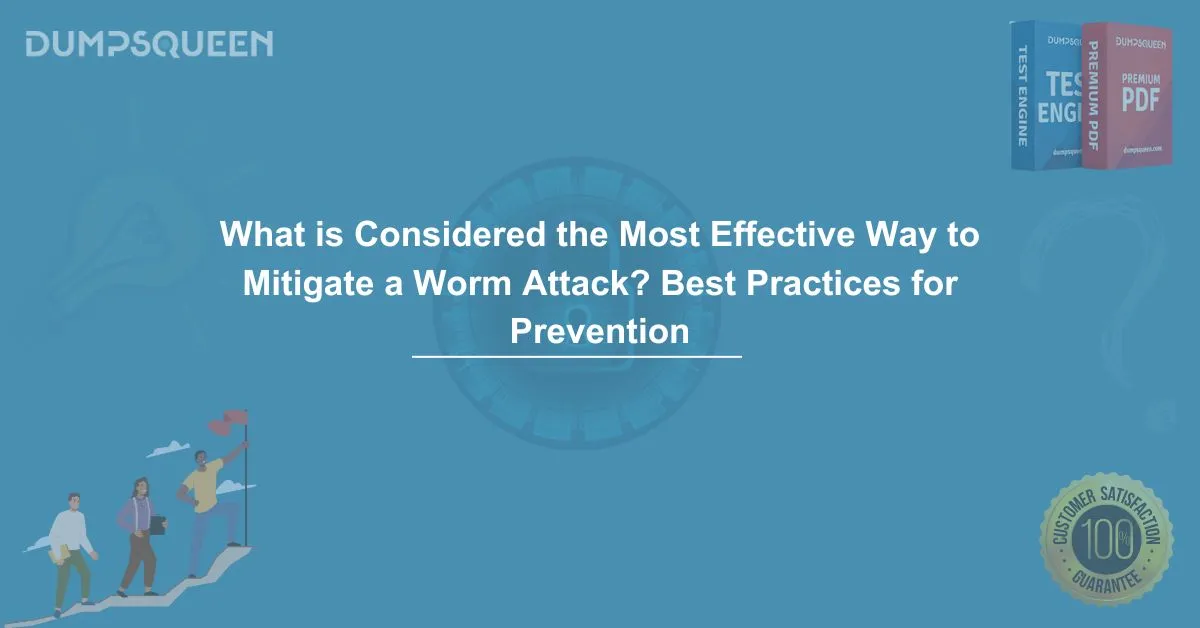What is Considered the Most Effective Way to Mitigate a Worm Attack?
Worm attacks are one of the most prevalent and dangerous cybersecurity threats that organizations and individuals face today. These self-replicating programs can spread rapidly across networks, infecting multiple systems in a short period. Given the destructive nature of worms, it is essential for businesses and individuals to understand the most effective ways to mitigate the impact of these attacks.
In this blog, we will explore what worm attacks are, how they work, the potential damage they can cause, and most importantly, what is considered the most effective way to mitigate a worm attack? We’ll also delve into best practices, tools, and preventive measures to help minimize the risks associated with these malicious programs.
What Is a Worm Attack?
A worm is a type of malware that replicates itself and spreads across networks without any user intervention. Unlike a virus, which requires a host file or program to execute, a worm can autonomously replicate and distribute itself across systems, exploiting vulnerabilities in software and operating systems. Worms can infect multiple computers in a short period, causing widespread damage.
Worms typically exploit security vulnerabilities, such as unpatched software or weak passwords, to propagate across networks. Once a system is infected, the worm can steal data, damage files, or even create backdoors that allow cybercriminals to control the infected machine remotely.
The rapid spread of worms makes them particularly dangerous, as they can cause significant disruption to an organization’s network. In some cases, worms are used as delivery mechanisms for other types of malware, such as ransomware or spyware.
How Do Worms Spread?
Worms generally spread through one or more of the following methods:
-
Network Exploits: Worms can spread via vulnerabilities in network protocols or software. For example, an email worm might exploit a weakness in an email client to infect multiple users within an organization.
-
Email Attachments: Many worms spread by sending infected attachments to contacts within an infected user’s email address book. When the attachment is opened by another user, the worm replicates and spreads further.
-
File Sharing: Worms can also spread through peer-to-peer (P2P) file sharing networks, often disguised as legitimate files or software.
-
Removable Media: Worms can be transferred through infected USB drives, external hard drives, and other forms of removable media, exploiting autorun features in some operating systems.
-
Weak Passwords and Unpatched Software: Worms often exploit weak passwords or vulnerabilities in outdated software. Once they gain access to one system, they can propagate across an entire network, infecting other machines.
What is Considered the Most Effective Way to Mitigate a Worm Attack?
The most effective way to mitigate a worm attack is by implementing a combination of proactive security measures, timely updates, and continuous monitoring. Let's discuss some of the most critical strategies for mitigating worm attacks.
1. Regularly Update Software and Systems
One of the best ways to protect against worm attacks is by keeping all systems and software up to date. This includes both the operating systems and applications. Software vendors frequently release patches to fix vulnerabilities that could be exploited by worms. Failure to apply these updates leaves systems open to attack.
-
Operating System Updates: Ensure that security patches for the operating system are applied as soon as they are available. Operating systems, such as Windows, Linux, and macOS, often have automatic update features that can be configured to download and install patches automatically.
-
Application Patches: Alongside operating system updates, applications like web browsers, email clients, office suites, and security software also require regular updates. Attackers often exploit vulnerabilities in these applications to spread worms.
Best Practice: Implement a robust patch management strategy to automate and monitor updates across all systems in the organization.
2. Use Firewalls and Intrusion Detection Systems (IDS)
Firewalls play a crucial role in blocking unauthorized access to a network. By properly configuring firewalls, organizations can prevent worms from spreading and protect critical assets. Firewalls can restrict communication from known malicious IP addresses and block traffic from untrusted sources.
In addition to firewalls, Intrusion Detection Systems (IDS) are essential for identifying malicious activity within a network. IDS can detect unusual network traffic patterns and alert security teams to potential worm activity. Combined, firewalls and IDS provide a strong defense against worm attacks.
Best Practice: Use both perimeter and host-based firewalls and IDS to monitor, detect, and block worm activity across your network.
3. Implement Network Segmentation
Network segmentation involves dividing the network into smaller, isolated segments. This limits the ability of a worm to spread rapidly across the entire network. If a worm infects one segment, it will be harder for it to move to other segments of the network, thus containing the damage.
For example, an organization may have different network segments for finance, HR, and IT, with strict access controls between these segments. If one segment is infected, it will be more difficult for the worm to propagate to other critical areas.
Best Practice: Implement network segmentation to limit the lateral movement of worms within the network.
4. Use Antivirus and Anti-Malware Software
Another essential step in mitigating worm attacks is using robust antivirus and anti-malware software. These tools can detect known worms, block their execution, and remove them from infected systems. Many modern security solutions offer real-time scanning, which can identify malicious files before they are executed.
While antivirus software is essential, it is not enough to rely solely on it. Antivirus signatures must be regularly updated to keep up with the evolving threat landscape, as new worms are discovered frequently.
Best Practice: Ensure that antivirus software is installed and updated on all systems, and conduct regular scans to detect potential infections.
5. User Education and Awareness
Human error is often a primary cause of worm infections. Users may inadvertently download infected files, click on malicious links, or open dangerous email attachments. Educating employees about the risks of worms and how to avoid falling victim to attacks is crucial.
Training employees to recognize suspicious emails, avoid downloading files from unknown sources, and implement good security practices like using strong passwords and enabling multi-factor authentication (MFA) can significantly reduce the risk of a worm attack.
Best Practice: Conduct regular cybersecurity awareness training and phishing simulation exercises to help employees recognize and avoid security threats.
6. Use Email Filtering and Blocking
Since worms often spread through email, it’s crucial to implement strong email filtering systems that can identify and block malicious attachments, links, or phishing emails. Modern email security solutions use AI-powered threat detection to flag and quarantine suspicious messages before they reach the inbox.
Best Practice: Configure email filtering systems to scan attachments and links for known malware and phishing attempts.
7. Conduct Regular Backups
In the event that a worm successfully infects systems and causes damage, having a comprehensive backup strategy in place ensures that data can be restored with minimal disruption. Regularly backing up critical systems and data allows organizations to recover from an infection without suffering significant data loss.
Backups should be stored offsite or in a secure cloud environment, and organizations should periodically test backup restoration processes to ensure they work effectively.
Best Practice: Implement a regular backup schedule and ensure that backups are secure and easily retrievable.
Conclusion
Worm attacks can cause significant harm to organizations, from data loss and downtime to financial damage and reputation destruction. The most effective way to mitigate a worm attack is through a multi-layered security approach that includes regular updates, robust firewalls, antivirus protection, user education, and effective network management strategies. By proactively addressing vulnerabilities and implementing these best practices, businesses can significantly reduce the risk of worm infections and enhance their overall cybersecurity posture.
The key takeaway is that preventive measures, early detection, and rapid response are essential to combating worm attacks. With the right tools and strategies in place, organizations can not only protect their networks but also ensure business continuity in the face of evolving cyber threats.
Limited-Time Offer: Get a Special Discount on CompTIA CAS-003 Exam Questions Order Now!
Sample MCQs for Worm Attack Mitigation
Here are a few sample MCQs based on the content of this blog:
-
What is the most effective way to mitigate the spread of a worm attack in an organization?
A) Ignoring software updates
B) Using firewalls and intrusion detection systems
C) Allowing open network access for all devices
D) Disabling antivirus softwareAnswer: B) Using firewalls and intrusion detection systems
-
Which of the following is a critical strategy for preventing worm infections on a network?
A) Limiting the number of devices on the network
B) Implementing network segmentation
C) Disabling email filtering systems
D) Allowing remote access for all employeesAnswer: B) Implementing network segmentation
-
What role does antivirus software play in mitigating worm attacks?
A) It blocks suspicious websites
B) It detects and removes worms from infected systems
C) It updates operating systems automatically
D) It encrypts sensitive dataAnswer: B) It detects and removes worms from infected systems
-
Why is user education important in mitigating worm attacks?
A) It helps employees detect phishing emails and suspicious links
B) It reduces the need for antivirus software
C) It helps IT teams patch vulnerabilities faster
D) It eliminates the need for network segmentationAnswer: A) It helps employees detect phishing emails and suspicious links




